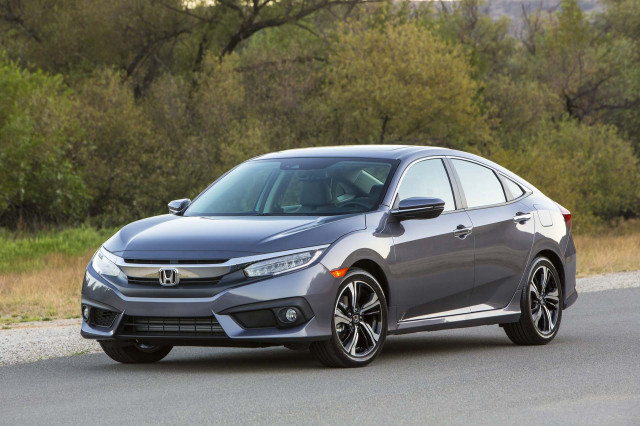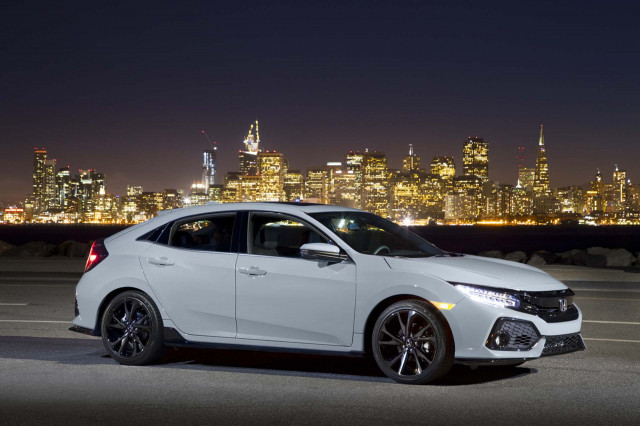The price and specifications of a car Honda Civic Research 2018
The price and specifications of a car Honda Civic Research 2018
The Honda Civic is one of the best-selling, most widely recognized car lines in the world. Across nearly a dozen generations, the Civic has come in many shapes, sizes, and models. It's now offered as a sedan, hatchback, or coupe
With the Civic, Honda has built an enviable reputation for durability and longevity. The Civic has another ace up its sleeve, too: efficiency. Over time, the Civic family has included natural-gas-powered and hybrid gas-electric models. Even the standard gas-powered models earn high fuel economy without much effort on the part of the driver, making them excellent choices for commuters
A size larger than the Fit hatchback, the Honda Civic slots in beneath the Honda Accord in the company's lineup. With the Civic, Honda has a rivals for cars such as the Mazda 3, Toyota Corolla, Nissan Sentra, Ford Focus, Chevy Cruze, and Hyundai Elantra, among others
After a flurry of new hatchbacks and performance models added in 2017, the Honda Civic was largely identical for 2018

MORE: Read our 2018 Honda Civic review
The new Honda Civic
The 2016 model year ushered in a new Civic, with a slew of new body styles and features, including the first turbocharged engine sold by Honda in America
The Honda Civic has been on sale in the U.S. for five decades, and it's now in its 10th generation. Over the years, the Civic has represented efficient transportation for small families or commuters, mostly at affordable prices
The Civic sedan was the first of the new generation to arrive, eventually joined by a hatchback and a coupe. It's the best-looking car Honda has drawn in a decade, with a beautifully edgy fastback shape that hides the gains in size very well. The cabin's a bit more tame, but well organized, with a broad horizontal theme that wouldn't look out of place in a BMW
Honda offers two new engines in the new Civic. The base four-cylinder is a 2.0-liter engine, with 158 horsepower, coupled to either a 6-speed manual or an automatic continuously variable transmission (CVT). With either transmission, this Civic delivers even-handed, if unremarkable, power, but excellent fuel economy of up to 35 miles per gallon on the combined cycle, according to the EPA. For more lively performance, the turbo 1.5-liter inline-4 is an obvious upgrade to take: it gets the same fuel economy ratings as the CVT-equipped base inline-4, but acceleration is quick enough to merit a sportier, Si badge. What really sets the new Civic apart from its past is excellent ride and handling, thanks to a trick steering setup and hydraulic suspension mounts; it's so composed and compliant, it feels like a much more capable and expensive car
The new Civic is much bigger than before, up to 3 inches longer and nearly 2 inches wider. Interior space and comfort have improved by a big margin, with a low driving position, excellent bucket seats, and very good rear-seat space that serve as its hallmarks. The feds haven't yet crash-tested the Civic, but the IIHS gave the car glowing marks: top, "Good" ratings for every crash test and a "Superior" front crash prevention result (when equipped with applicable options). Prices range from about $20,000 to just above $27,000

The 2016 Honda Civic sedan was named the North American Car of the Year
A new Civic Coupe arrived as a 2016 model and a new hatchback was introduced in the fall. The hatchback model is available only with the turbo-4 and is the first shot before Honda brings over its ultra-hot Type R hatchback in 2017. It was Motor Authority's Best Car to Buy 2018
Honda Civic history
The Civic first came to the U.S. in the early 1970s. While in non-Rust Belt states there are no doubt many running examples of Honda Civic models dating back to the 1970s and 1980s, the 1990s-era Civics are currently the most common older Civic models still widely in circulation. These Civics mostly have 1.5- and 1.6-liter engines of various outputs; Honda's VTEC system was phased into the Civic's engine line in 1992 and allowed the model to be both faster and more fuel-efficient than many other small cars of that era. The Civic was also one of the few inexpensive small cars to have an independent rear suspension, giving it ride and handling traits that easily beat the norm
The Civic that was sold from 2001 through 2005 was only sold as a rather drab sedan in the U.S.—except for the sporty Si model—but what it lacked for style it made up in all-around performance, with good fuel economy as well, and a roomy interior. Some enthusiasts weren't thrilled with the change to a strut front suspension. This generation marked the debut of a Civic Hybrid model, borrowing the Integrated Motor Assist (IMA) system that had made its debut in the earlier Insight coupe
With radically different, aerodynamically optimized exterior styling and a completely reimagined twin-level instrument-panel design, the Civic that was offered from 2006 to 2011 came in sleek coupe or sedan variants, with a 140-horsepower, 1.8-liter 4-cylinder engine on most (DX, LX, EX, and EX-L models). The Civic Hybrid model returned, with a CVT transmission and 110-hp mild-hybrid system good for an EPA 40 mpg city, 45 highway, and a natural-gas-fueled GX model was also on offer. This time around, the Civic Si model had an excellent 197-horsepower, 2.0-liter inline-4 and 6-speed manual—other versions had a 5-speed manual or 5-speed automatic. Again, the Civic was praised for its fuel economy and peppy driving feel with nearly any of its variants, but backseat head room was limited because of the sloping roofline
While many think of the Civic as solely a basic, no-frills vehicle, in that 2006-2011 generation the top-of-the-line Civic EX models grew even more luxurious, with leather upholstery, heated seats, and even a navigation system
The Civic was last redesigned for the 2012 model year, but in a rare error of judgment, Honda's designers erred too far on the side of austerity, using grim, cheap, hard plastics for the interior and stinting on things such as sound insulation. While the 2012 Civic sold fine, reviewers savaged the car as not up to Honda's usual standards. Just 16 months later, the 2013 models arrived with new front and rear styling, and a redesigned and more upscale interior. We drove the improved 2013 Civic and indeed found it to be better in many respects
More than a typical mid-cycle refresh, the 2013 Honda Civic received a somewhat different look modeled after the new Accord, plus an expanded feature set, including standard Bluetooth, text-message functionality, Pandora integration, and a rearview camera—all standard—while optional navigation systems were upgraded with subscription-free, FM-based traffic info. Most importantly, the cabin was given new materials, as well as extra noise insulation. Civic Hybrids also received new standard active safety, with forward-collision and lane-departure warning systems
There were some significant updates for 2014. The Civic coupe's front end was completely redesigned to be more aggressive and in line with the latest Accord two-door. The automatic transmission was replaced with a CVT, which improved fuel economy, while redesigned exhaust systems on most models bumped up horsepower and torque figures. There were also feature and technology updates, chief among them a new 7.0-inch touchscreen radio
This Civic lineup was as wide-ranging as it had ever been, offering a variant for almost any compact-car shopper. Base models used a simple 4-cylinder gas engine, while the hot Si coupe and sedan offered sportier handling and more power with equally tuned looks. Enviro-conscious shoppers could opt for the Civic Hybrid sedan, which hit 45 mpg combined using its single-motor IMA hybrid system. There also was a Natural Gas model, which was fueled by compressed fuel stored in an in-trunk tank
Leave a Comment